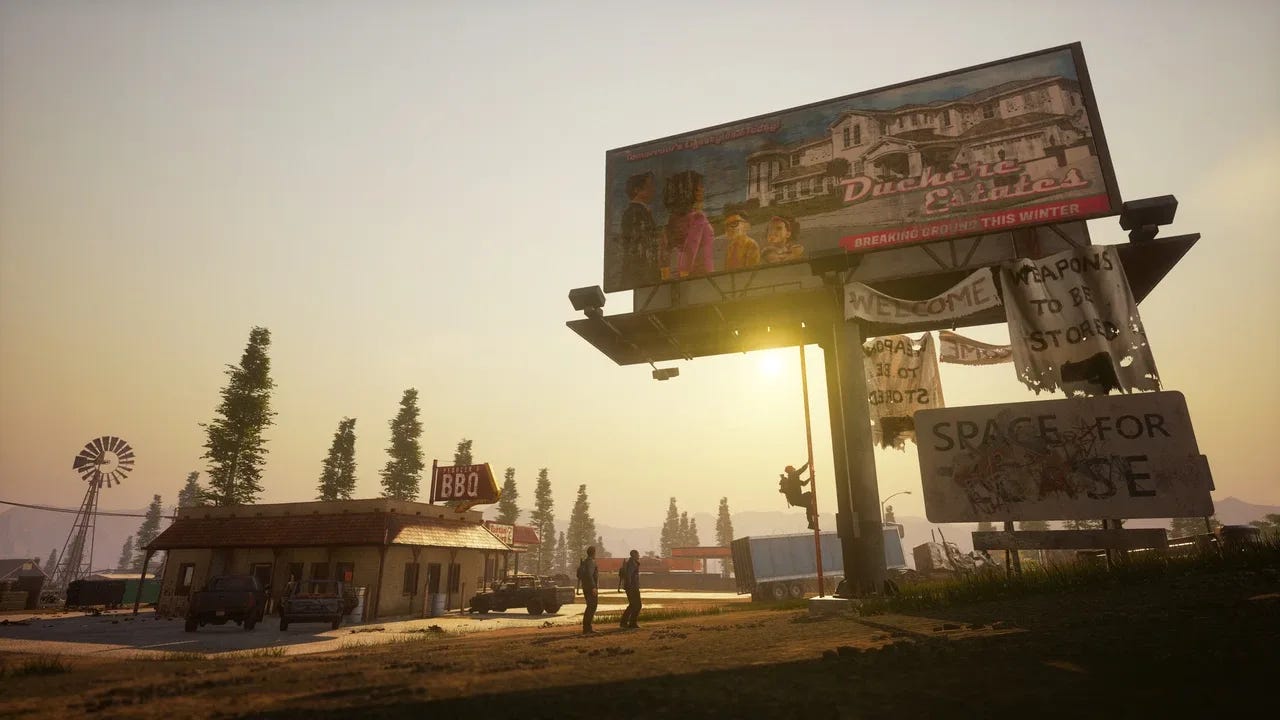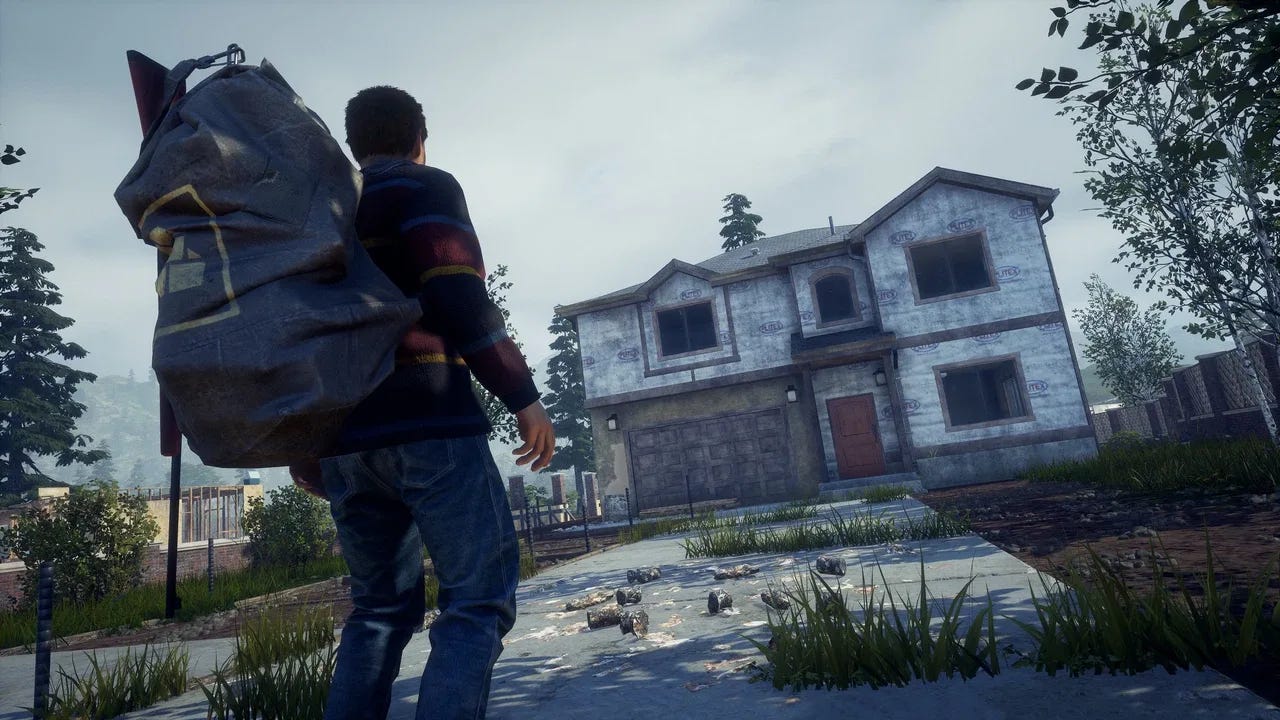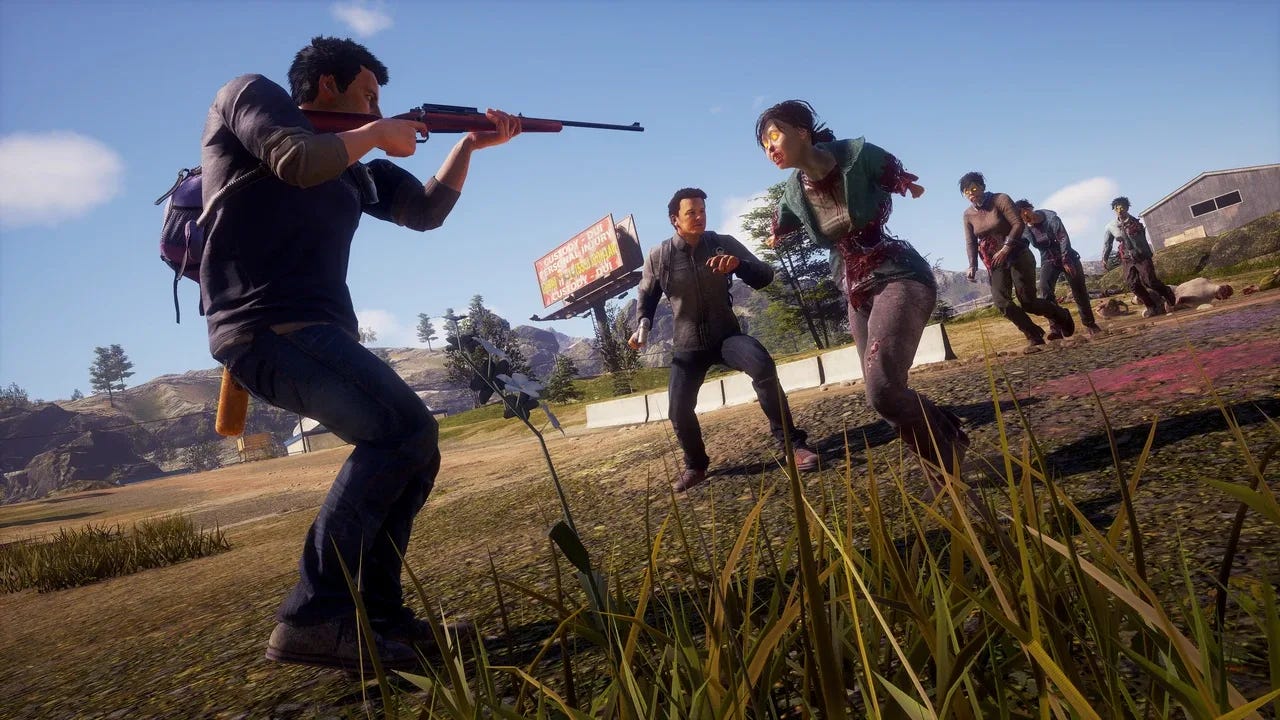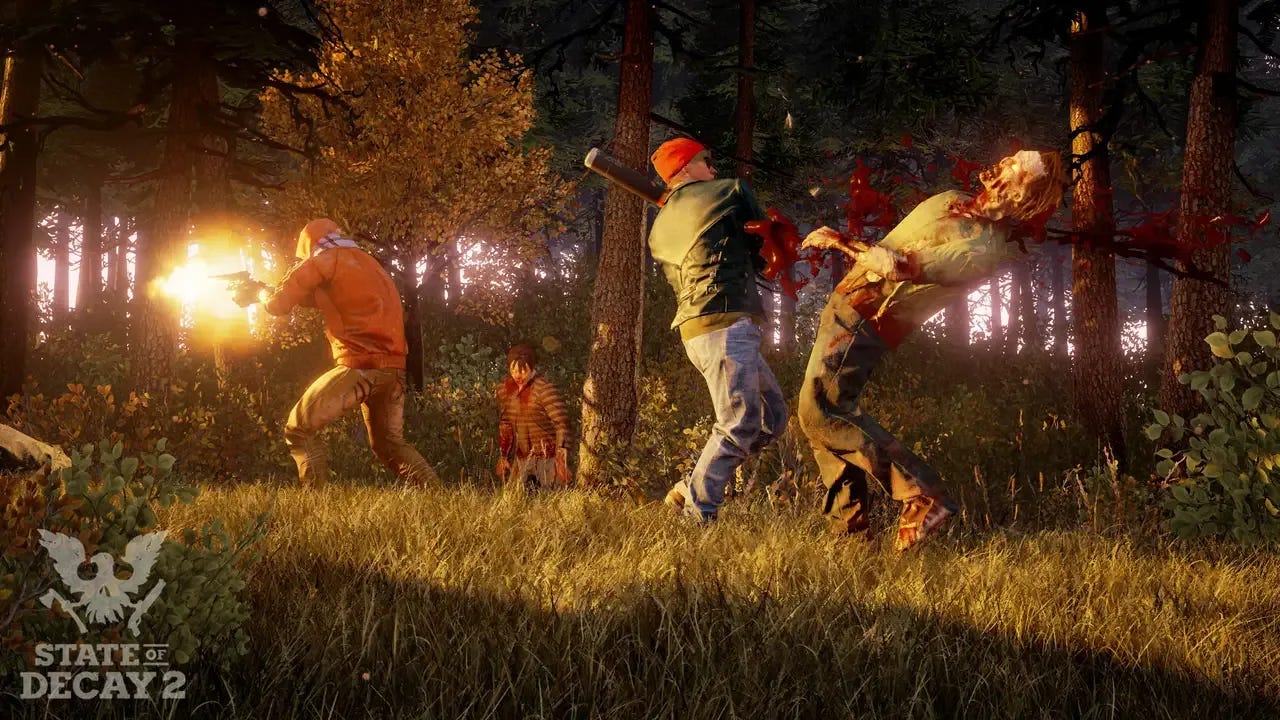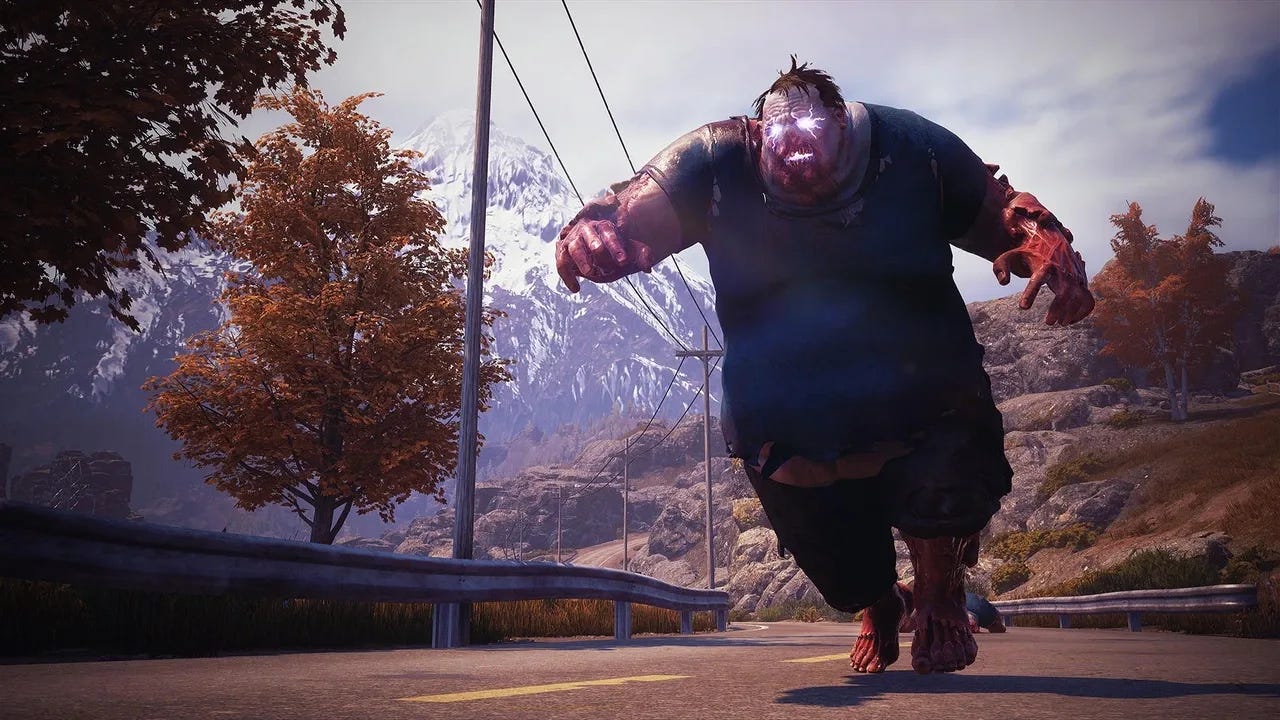State of Decay 2's Modular Difficulty Can Turn it into a Fun Romp or an Unliving, Reactive Struggle
State of Decay 2 can either be a vacation at the end of the world or an emergent fight for survival. Both are enjoyable modes of play, and the game is more than happy to let you do either.
State of Decay 2 is an emergent zombie survival game about a procedurally generated community of people scavenging, building, and fighting to survive in a world where nothing is free, and time always takes its toll. The thing is, the game didn't feel that way for most of my time with it. Until my most recent playthrough, which follows "The Remains of Society" (chosen randomly,) most SoD2 games have been relative walks through barely infected parks, where progress was constant and failure only visited after gross negligence on my part. It provided a fun experience, but not necessarily a tense or particularly evocative one.
Here's the basic arc for a game of SoD2: Your community of three random survivors decides to stop their wandering and settle down on a map of your choice, where they move into a starter base. You're tasked with random quests by people inside and outside of your community, which builds up the standing of the played character, eventually unlocking a unique Hero bonus for your community and allowing that character to become your community's Leader. There are four types of Leader, which set the tone for many of the challenges your community will face, especially from NPC enclaves of survivors.
Expansion from your starter base is gated by the size of your community and influence requirements: currency representing goodwill your community has with the rest of the map. By spending influence, your community can setup remote outposts that can provide regular resource deliveries, safe zones from undead, places to deposit items away from your base, and a number of other benefits. You can also move to larger home bases with more slots for construction, or other unique prebuilt benefits, as long as buildings aren't locked down by plague hearts.
Plague hearts make up the first half of the main objective of a run of SoD2. Areas around plague hearts have higher concentrations of plague zombies, which can infect and turn members of your community if they deal enough damage to you. Buildings within plague zones cannot be made into zombie safe zones, even temporarily, meaning that you cannot secure outposts or potential base sites for capture without destroying nearby plague hearts first.
Plague hearts also send out infesting hordes towards your base and outposts, which can shut down outposts until they are cleared, or can siege your base if left unchecked. Clearing plague hearts can be a very dangerous task, as they have a lot of health and don't go quietly, periodically dealing AoE damage around them and screaming for help, meaning that herds of plague zombies will come to eat you as you try to burn them out.
Clearing all the plague hearts on the map unlocks the legacy objectives for your chosen leader, a series of quests testing the resolve of your community from within and without. Completing them marks the end of the game and unlocks bonuses for future runs, where you can carry over specific characters from your other games.
Though the game launched with two fairly tame difficulty settings, post launch updates have made the difficulty in SoD2 modular, allowing players to get granular when choosing how punishing three different aspects of the game are, namely the Action, Community, and Map sliders. Shifting them up the difficulty scale will drastically alter the feel and tone of your game, which completely redefined how I interact with and think about the experience as a whole. Overall, the zombie plague is more, taxing, punishing, and alive on higher difficulties, forcing you to react more than act, and putting you on the backfoot more often.
The Community slider determines the resource costs of building and survival, adds an overall community morale modifier, increases the threat of hordes invading your base and changes the rate that survivors gain experience and influence in and around their community.
The Remains of Society, for the first time in my experience, has had internal strife between members of our own community. For the first time in 5 playthroughs, Morale was low enough for a long enough time to actually influence my decision making as a leader. Lack of running water, beds, and medicine have caused fights, especially between Dharla, our cook, and Noah, a new member and computer expert, who each have a penchant for being cranky, and a lower tolerance for the other's crap in particular thanks to their random personality traits. Both have threatened to leave if the other didn't, though it hasn't yet come to that.
Before playing on Nightmare mode, morale was a system I had practically ignored entirely, as it's entire function before seemed to be to snowball a successful run into a winning one more quickly. On Nightmare mode, though, resources have been scarce enough to cause numerous fights that spin out into the rest of the community, threatening to push the Remains of Society into a nosedive that might kill everyone of us one by one. It takes a lot of resources to live comfortably, and even more to get a sustainable supply. How easy it is to find those resources is set by the Map difficulty, and how difficult and expensive it is to get those resources and bring them home is set by the Action difficulty.
The Action slider dictates zombies and their behavior; how many zombies there are, the damage enemy zombies and NPCs do, how much health they have, how often special "freak" zombies spawn, and how long after becoming infected before a character turns themselves.
While the other two sliders can really tighten the screws on the player, the Action difficulty is the beating heart of challenge in SoD2. Honestly, dealing with tough morale penalties from the Community slider, and exterminating increased infestations and more aggressive raids wouldn't be an issue with care and good preparation. Here's the problem: the Action slider ups the amount of freaks, special zombies that usually cost you ammo to deal with safely, especially since the Nightmare difficulty gives some of them blood plague.
You're probably starting to see the problems I've faced in my two Nightmare runs so far. Starting in a worse position thanks to morale penalties and lower margins for error push your further and farther with less opportunity for strategies that guarantee your own safety. Dealing with all of the extra pressure from freaks like Ferals, loud zombies that outrun your character and tear them down to the ground wouldn't necessarily be an issue, except every other zombie is more lethal. Ferals on their own (in their non-plague state,) are a complete non-issue, as long as you have the bullets and reactions to one tap them as they rush you. Setting the map difficulty to Nightmare, like I have, has dramatically reduced the bullets that I've been able to supply.
The Map slider determines how often resource rucksacks spawn, how much supplies they hold, how many items players can find, the amount and starting health of vehicles, the amount of plague hearts there are, their density, amount, and health, and how rare the plague samples required to craft the cure are.
Like bullets for Ferals, vehicles are one of the tried and true methods of reliable zombie cleansing on lower difficulties of SoD2. The Nightmare difficulty dramatically lowers the overall health of vehicles, so that each zombie you paste onto the road is a meaningful choice you have to make, especially since vehicle repair is so much harder to come by. In early difficulties, entire hordes are mowed down under your sedans, slowed only by the threat of Bloaters, which explode in a cloud of poison gas that sticks to cars and reduces your max health very quickly. Normally in SoD2, bloaters force you to change your path or have to bail from a moving car. Nightmare makes them all Plague Bloaters, and mixes them with other high value targets like Screamers so that even traversal is much more dangerous. The map difficulty also makes plague hearts significantly more dangerous and difficult to deal with.
I haven’t even covered the curveball system, where limited time mutations help or hurt your journey to pushing back the zombie threat, or how the game is happy to let you skirt its hardest moments with multiplayer, or rewards from other game modes. Those are great post-launch changes to encourage you to try different and harder experiences, and the game is better for them.
Every aspect of the games difficulty folds back into another system or mechanic, making the game much less of an easy road to heroic triumph and instead a slower, more stealth focused cautionary tale, where characters are pushed to the brink and death can jump out at you from any corner. Sometimes you suffer a long tailspin where little issues pile up and up until you drown underneath them, and sometimes killing a plague heart kills all the nearby zombies but the two giant juggernauts that pound you into the pavement after destroying car you used to get there.



